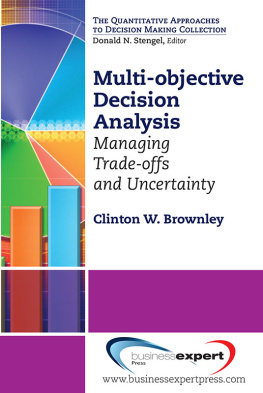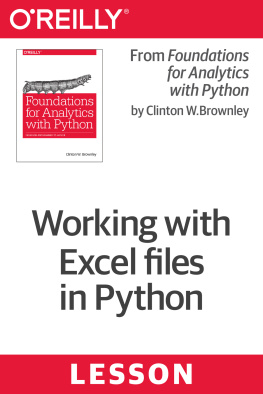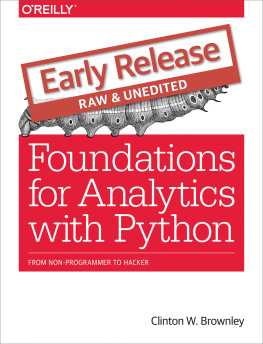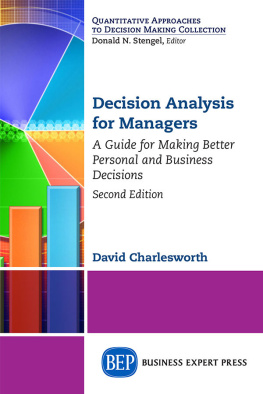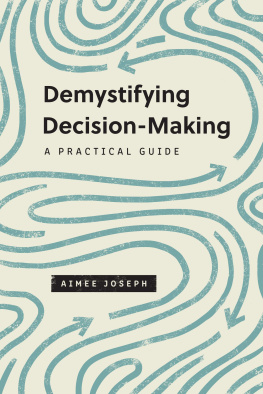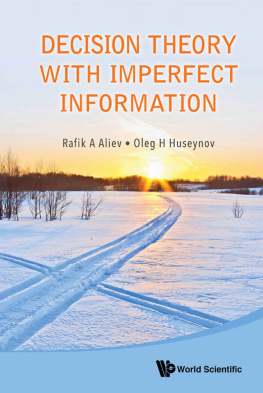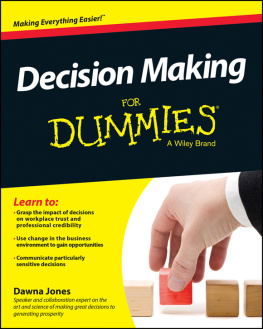Multi-objective Decision Analysis
Multi-objective Decision Analysis
Managing Trade-offs and Uncertainty
Clinton W. Brownley, Ph.D.

Multi-objective Decision Analysis: Managing Trade-offs and Uncertainty
Copyright Business Expert Press, 2013.
All rights reserved. No part of this publication may be reproduced, stored in a retrieval system, or transmitted in any form or by any meanselectronic, mechanical, photocopy, recording, or any other except for brief quotations, not to exceed 400 words, without the prior permission of the publisher.
First published in 2013 by
Business Expert Press, LLC
222 East 46th Street, New York, NY 10017
www.businessexpertpress.com
ISBN-13: 978-1-60649-452-3 (paperback)
ISBN-13: 978-1-60649-453-0 (e-book)
Business Expert Press Quantitative Approaches to Decision
Making c ollection
Collection ISSN: 2163-9515 (print)
Collection ISSN: 2163-9582 (electronic)
Cover and interior design by Exeter Premedia Services Private Ltd.,
Chennai, India
First edition: 2013
10 9 8 7 6 5 4 3 2 1
Printed in the United States of America.
For my wife, Anushka, who insists goals can be achieved through
focus, enthusiasm, and perseverance
Abstract
Whether managing strategy, operations, or products, making the best decision in a complex, uncertain business environment is challenging. One of the major difficulties facing decision makers is that they often have multiple, competing objectives, which means trade-offs will need to be made. To further complicate matters, uncertainty in the business environment makes it hard to explicitly understand how different objectives will impact potential outcomes. Fortunately, these problems can be solved with a structured framework for multiobjective decision analysis that measures trade-offs among objectives and incorporates uncertainties and risk preferences.
This book is designed to help decision makers by providing such an analysis framework implemented as a simple spreadsheet tool. This framework helps structure the decision-making process by identifying what information is needed in order to make the decision, defining how that information should be combined to make the decision, and, finally, providing quantifiable evidence to clearly communicate and justify the final decision.
The process itself involves minimal overhead and is perfect for busy professionals who need a simple, structured process for making, tracking, and communicating decisions. With this process, decision making is made more efficient by focusing only on information and factors that are well defined, measureable, and relevant to the decision at hand. The clear characterization of the decision required by the framework ensures that a decision can be traced and is consistent with the intended objectives and organizational values. Using this structured decision-making framework, anyone can effectively and consistently make better decisions to gain a competitive and strategic advantage.
Keywords
decision making, decision analysis, decision modeling, strategic decisions, business decisions, how to decide, trade-offs, multiobjective, values, weights, value functions, objectives, measures, alternatives, uncertainty, probability, discrete, continuous, linear, exponential, expected value, utility, expected utility, risk tolerance, certainty equivalents
Contents
A book like this cannot be written without help from many people. Four in particular played key roles. First and foremost, I want to thank my wife, Anushka, for being patient and supportive during all of the nights and weekends I spent writing. An insightful reviewer, she also suggested many ways to make the book more consistent, clear, and concise. Second, I want to thank Steven Nahmias for reviewing the manuscript and providing helpful suggestions. Third, I want to recognize Cindy Durand for providing excellent production assistance. She provided superb guidance on gathering permissions, organizing the images and tables, and compiling the index. Finally, I owe a special debt to the collections editor, Don Stengel, for shepherding this book from start to finish, improving it with his editorial direction, and providing a cheerful, professional hand throughout.
I also want to thank the staff of Business Expert Press, especially Scott Isenberg and David Parker, for their support and assistance with this project. Scott provided seasoned advice on an assortment of topics and was also tremendously helpful during the manuscript review process.
Finally, I want to acknowledge that Multi-objective Decision Analysis reflects an intellectual journey as well as a writing project. I first became interested in decision analysis as an aid to judgment and decision making while I was a student at Carnegie Mellon University. At CMU, I had the great fortune to receive instruction, research experience, and inspiration from many distinguished decision scientists and operations researchers, including Paul Fischbeck, Baruch Fischhoff, George Loewenstein, Don Moore, Otto Toby Davis, Robyn Dawes, Herbert Simon, M. Granger Morgan, Jonathan Caulkins, Alfred Blumstein, Michael Trick, and Michael Johnson.
Since then, I have enriched my understanding of decision analy sis and other effective techniques for strategic decision making by studying and implementing the methodologies of many other exceptional decision scientists, including Ward Edwards, Detlof von Winterfeldt, Craig Kirkwood, Howard Raiffa, Ronald Howard, Robert Schlaifer, Ralph Keeney, Robert Clemen, Robert Winkler, Reid Hastie, Harold Sox, Peter Moore, Howard Thomas, John Hammond, John Magee, Robin Hogarth, Hillel Einhorn, Rex Brown, Kenneth Hammond, Daniel Kahneman, Amos Tversky, Richard Thaler, Thomas Gilovich, Paul Slovic, Max Bazerman, Scott Plous, Jeffrey Keisler, Paul Goodwin, George Wright, Jacob Ulvila, David Hertz, Samuel Bodily, Myriam Hunink, Paul Glaziou, and Gerd Gigerenzer.
Each of these individuals has contributed to my understanding of decision analysis as an aid to judgment and decision making, and this book benefits enormously from the theoretical and applications-based advances they pioneered.
Your best hope for a good decision outcome is a good decision process.
J. Russo & P. Schoemaker
Todays business environment is fraught with complexity and uncertainty. A variety of factors contribute to such complexitythe desire to achieve multiple objectives at once, the wish to address the values and attitudes toward risk of multiple stakeholders, the difficulty of identifying suitable alternatives, the challenge of measuring intangibles, and the often impossibility of precisely predicting the future consequences of alternatives. While it would be magnificent if it were otherwise, complexity is inherent to the business environment, so it cannot be avoided.
Such complexity makes it incredibly difficult to make important decisions informally in a defensible manner. And in todays high-stakes business environment, managers need to be able to justify and defend their decisions to a variety of impacted groups, including shareholders, bosses, co-workers, the public, and themselves. Since informal analysis is likely to be insufficient for most key business decisions, professionals need a formal methodology and set of tools they can use to make and justify their decisions.
What Constitutes a Decision?
Since multiobjective decision analysis is a methodology that helps people make informed decisions, it is important to first understand what a decision is. A decision is an opportunity to make a choice between at least two different things. That is, for a decision to exist there must be at least two alternatives. Not having any alternatives may be a problem, but its not a decision problem. And, of course, the attractiveness of the alternatives matters. It can be very frustrating to face a decision situation in which there seem to be no good alternatives.
Next page
